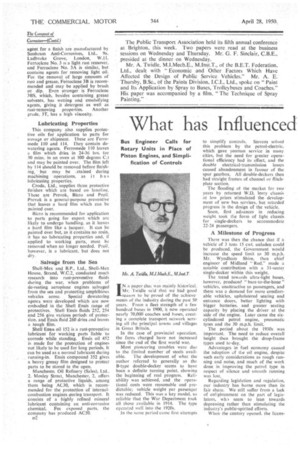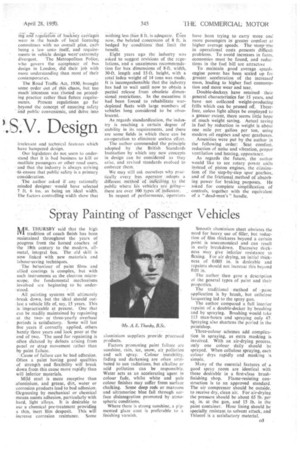What has Influenced ).S.V. Design
Page 80

Page 81

If you've noticed an error in this article please click here to report it so we can fix it.
IN ) .a•paper-that was mainly historical.
Mr. TWidle sii:d that We had good 'reason to be. proud of the achievements of the industry during the past 50 years. From a fleet strength of a few hundred buses in 1900,11 now operated nearly 70,000 coaches and buses, creating a complete transport network serving all the principal towns and villages in Great Britain.
In the case of provincial operation, the fares charged have not increased since the end of the first world war.
Most pioneering troubles were diae to the limited number of steels avail able. The development of what the author referred to generally as the B-type double-decker seems to have been a definite turning point, showing the beginning of real progress. Reliability was achieved, and the operational costs were reasonable and predictable; vehicle weight per passenger was reduced. This was a key model, so reliable that the War Department took all those available in 1914, The type operated well into the 1920s.
In the same period came first attempts to simplify controls. Stevens solved this problem by the petrol-electric, which gave yeoman service in many cities, but the need for greater operational efficiency had its effect, and the double electrical-transmission losses caused abandonment in favour of the spur gearbox. All double-deckers then had straight frames of channel or flitchplate section.
The flooding of the market for two years by returned W.D. lorry, chassis at low prices stimulated the development of new bus services, but retarded progress in the design of the vehicle.
Soon, first advances in reducing weight took the form of light chassis for single-deckers to accommodate 22-24 passengers.
A Milestone of Progress
There was then the chance that if a vehicle of 3 tons 15 cwt. unladen could be produced, the Government would increase the speed limit to 30 Mr. Wyndham Shire, then chief engineer of Midland Red," made a notable contribution with a 31-seater single-decker within this weight.
The trend towards ultra-light buses, however, produced "bare-to-the-bone" vehicles, unattractive to passengers, and there was a demand for more comfortable vehicles, upholstered seating and entrance doors, better lighting with bigger batteries, and greater seating capacity by placing the driver at the side of the engine. Later came the sixcYlindered petrol engine, pneumatic tyres and the 30 m.p.h. limit.
The period about the 1930s was important. The need to reduce overall height then brought the drop-frame types used to-day.
Advantages, in fuel economy caused the adoption of the oil engine, despite such early considerations as rough running and noise, and much of the work done in improving the petrol type in respect of .silence and smooth running was lost.
Regarding legislation and reeulation, our industry has borne more than its fair share. We still suffer from a lack of enlightenment on the part of legislators, wh..i seem to lean towards depressing rather than stimulating' the inclitstry's public-spirited efforts.
When the century opened; the licens
44 an r-Clinrairo'n. Of haelcice Y 'Canine's were in the hands of local licensing committees with no overall plan, each being a law unto itself, and requirements-in vehicle design were'extremely
divergent. The Metropolitan Police; who govern the acceptance of bus design in London, did their job with more understanding than most of their contemporaries.
The Road Traffic Act, 1930,brought some order out pt this chaos, but too much attention was -riveted on preceding Practice rather than future requii-ements. Present regulations go far beyond the concept of ensuring safety :Titid public convenienee, and delve, into
irrelevant and technical features which have hampered design.
Our legislators do not seem to understand that it is had business to kill or mutilate passengers or other road users, and' that the industry is always striving 16 ensure that public safety is a primary consideration: The author asked if any rationally minded designer would have selected 7 ft. 6 ins, as being an ideal width. The factors controlling width show that
• Mithing less th`th't 8 ft. is adequate. Ceti now, the belated concession of 8 ft. is hedged by 'conditions' that limit the benefit.
Eight years ago the industry was asked to suggest revisions of the regulations, and a unanimous recommendation for box dimensions of 8-ft. width, 30-ft. length and 15-ft. height, with a total laden weight of 14 tons was made. It is incomprehensible that the industry has had to wait until now to obtain a partial release from obsolete dimensional restrictions. In the meantime it had been forced to rehabilitate wardepleted fleets with large numbers of vehicles long considered to be obsolescent.
As regards standardization, the industry is reaching a certain degree of 'stability in its requirements, and there are some fields in which there can be co-operation to eliminate useless effort. The author commended the principle adopted by the British Standards Institution by which any new concepts in design can be considered as they arise, and revised standards evolved to embrace them.
We may still ask ourselves why practically every .bus operator -adepts a different, Method of . indiedting to the public where his vehicles are going— there are over 100 types Of indicator.
In respect of performance, operators




































































































































































































